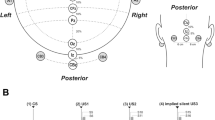Abstract
Rabbits received ibotenic acid lesions of the mediodorsal nucleus of the thalamus (MD), or sham lesions. These animals were compared on acquisition and reversal of a Pavlovian conditioned discrimination task in which tones were the conditioned stimuli and paraorbital electric shock was the unconditioned stimulus. Eyeblink and heart rate conditioned responses were assessed. Lesions of MD impaired the reversal, but not original acquisition, of the eyeblink discrimination. Heart rate discrimination was somewhat impaired during both acquisition and reversal. There were no differences between lesion and sham animals on control measures assessing general activity, somatomotor shock thresholds, or heart rate unconditioned responses.
Similar content being viewed by others
References
Buchanan SL (1988) Mediodorsal thalamic lesions impair differential Pavlovian heart rate conditioning. Exp Brain Res 73:320–328
Buchanan SL, Powell DA (1980) Divergencies in Pavlovian conditioned heart rate and eyeblink responses produced by hippocampectomy in the rabbit. Behav Neural Biol 30:20–38
Buchanan SL, Powell DA (1986) Electrical stimulation of anteromedial and mediodorsal thalamus elicits differential cardiovascular response patterns from conscious rabbits. Physiol Psychol 14:115–123
Buchanan SL, Powell DA (1989) Parasagittal thalamic knife cuts and cardiac changes. Behav Brain Res 32:241–253
Buchanan SL, Thompson RH (1990) Mediodorsal thalamic lesions and Pavlovian conditioning of heart rate and eyeblink responses in the rabbit. Behav Neurosci 104:912–918
Gabriel M (1990) Functions of anterior and posterior cingulate cortex during avoidance learning in rabbits. In: Uylings HBM, Van Eden CG, De BruinJPC, Corner MA, Feenstra MGP (eds) The prefrontal cortex: its structure, function and pathology. Progess in Brain Research, Vol 85. Elsevier Science Publishers B.V, Amsterdam, pp 467–483
Gabriel M, Sparenborg S, Kubota Y (1989) Anterior and medial thalamic lesions, discriminative avoidance learning, and cingulate cortical neuronal activity in rabbits. Exp Brain Res 76:441–457
Gormezano I (1966) Classical conditioning. In: Sidowski JB (ed) Experimental methods and instrumentation in psychology. McGraw Hill, New York, pp 385–420
Hernandez LL, Buchanan SL, Powell DA (1987) Somatomotor thresholds in the New Zealand albino rabbit. Psychol Rep 61:265–266
Huang Z, Varner KJ, Barman SM, Gebber GL (1988) Diencephalic regions contributing to sympathetic nerve discharge in anesthetized cats. Am J Physiol 254:R249-R256
Jarrell TW, Gentile CG, Romanski LM, McCabe PM, Schneiderman N (1987) Involvement of cortical and thalamic auditory regions in retention of differential bradycardiac conditioning to acoustic conditioned stimuli in rabbits. Brain Res 412:285–294
Kao K-T, Powell DA (1986) Lesions of substantia nigra retard Pavlovian somatomotor learning but do not affect autonomic conditioning. Neurosci Lett 64:1–6
Kapp BS, Wilson A, Pascoe JP, Supple W, Whalen PJ (1991) A neuroanatomical systems analysis of conditioned bradycardia in the rabbit. In: Gabriel M, Moore JW (eds) Neurocomputation and learning: foundations of adaptive networks, Bradford Books MIT Press, Cambridge MA (in press)
Kazis E, Milligan WL, Powell DA (1973) Autonomic-somatic relationships: blockade of heart rate and corneoretinal potential. J Comp Physiol Psychol 84:98–110
Neafsey EJ, Frysztak RJ (1989) Medial frontal cortex lesions eliminate ultrasonic vocalizations during stress in the rat. Soc Neurosci Abstr 15:274
Norman RJ, Buchwald JS, Villablanca JR (1977) Classical conditioning with auditory discrimination of the eyeblink in decerebrate cats. Science 196:551–553
Oakley DA, Russell IS (1972) Neocortical lesions and Pavlovian conditioning. Physiol Behav 8:915–922
Powell DA, Buchanan SL (1980) Autonomic-somatic relationships in the rabbit (Oryctolagus cuniculus): effects of hippocampal lesions. Physiol Psychol 8:455–462
Powell DA, Buchanan SL (1986) Chemical stimulation of the mediodorsal nucleus of the thalamus elicits autonomic adjustments. Pharmacol Biochem Behav 25:423–430
Powell DA, Buchanan SL, Gibbs CM (1990) Role of the prefrontalthalamic axis in classical conditioning. In: Uylings HBM, Van Eden CG, De Bruin JPC, Corner MA, Feenstra MGP (eds) The prefrontal cortex: its structure, function and pathology. Progress in Brain Research, Vol 85. Elsevier Science Publishers BV, Amsterdam, pp 433–466
Powell DA, Joseph J (1974) Autonomic-somatic interactions and hippocampal theta activity. J Comp Physiol Psychol 87:978–986
Powell DA, Levine-Bryce D (1988) A comparison of two model systems of associative learning: heart rate and eyeblink conditioning in the rabbit. Psychophysiology 25:672–682
Powell DA, Lipkin M, Milligan WL (1974) Concomitant changes in classically conditioned heart rate and corneoretinal potential discrimination in the rabbit (Oryctolagus cuniculus). Learn Motivat 5:532–547
Schneiderman N, Gormezano I (1964) Conditioning of the nictitating membrane of the rabbit as a function of CS-US interval. J Comp Physiol Psychol 57:188–195
Slotnick BM, Kaneko N (1981) Role of mediodorsal thalamic nucleus in olfactory discrimination learning in rats. Science 214:91–92
Squire LR (1986) Mechanisms of memory. Science 232:1612–1619
Staubli U, Schottler F, Nejat-Bina D (1987) Role of dorsomedial thalamic nucleus and piriform cortex in processing olfactory information. Behav Brain Res 25:117–129
Stokes KA, Best PJ (1988) Mediodorsal thalamic lesions impair radial maze performance in the rat. Behav Neurosci 102:294–300
Thompson RF, Donegan NH, Lavond DG (1988) The psychobiology of learning and memory. In: Atkinson RC, Herrnstein RJ, Lindsey G, Luce RD (eds) Stevens handbook of experimental psychology 2nd edn, Vol 2. Learning and cognition. John Wiley and Sons, New York, pp. 245–347
Urban U, Richard P (1972) A stereotaxic atlas of the new Zealand rabbit. Charles C Thomas, Springfield IL
Varner KJ, Barman SM, Gebber GL (1988) Cat diencephalic neurons with sympathetic nerve-related activity. Am J Physiol 254:R257-R267
Waring AE, Means LW (1976) The effect of medial thalamic lesions on emotionality, activity, and discrimination learning in the rat. Physiol Behav 17:181–186
Weis BJ, Means LW (1980) A comparison of the effects of medial frontal, dorsomedial thalamic, and combination lesions on discrimination and spontaneous alternation in the rat. Physiol Psychol 8:325–329
Zola-Morgan S, Squire LR (1985) Amnesia in monkeys after lesions of the mediodorsal nucleus of the thalamus. Ann Neurol 17:558–564
Author information
Authors and Affiliations
Rights and permissions
About this article
Cite this article
Buchanan, S.L. Differential and reversal Pavlovian conditioning in rabbits with mediodorsal thalamic lesions: assessment of heart rate and eyeblink responses. Exp Brain Res 86, 174–181 (1991). https://doi.org/10.1007/BF00231051
Received:
Accepted:
Issue Date:
DOI: https://doi.org/10.1007/BF00231051




